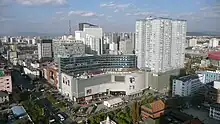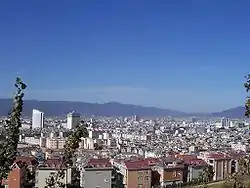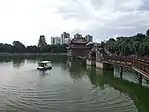Mengzi City
Mengzi (Chinese: 蒙自; pinyin: Méngzì; Hani: Maoqziif Siif) is a city in the southeast of Yunnan Province, China.[2] Administratively, it is a county-level city and the prefectural capital of the Honghe Hani and Yi Autonomous Prefecture, located about 243 kilometres (151 mi) southeast from Kunming, and 400 kilometres northwest from Hanoi, Vietnam.[3] It is situated in the centre of a fertile valley basin on the Yunnan-Guizhou Plateau[2] 1,310 metres (4,300 ft) above the sea level and was home to about 590,300 inhabitants as of 2021 census.[4] Mengzi was formerly Mengzi County (蒙自县) until October 2010, when it was upgraded to a county-level city.[5] Mengzi is the core region of the central city agglomeration of Southern Yunnan, which is officially regarded as the political, economic, cultural, and military centre of Southern Yunnan.
Mengzi
蒙自市 · Maoqziif Siif | |
|---|---|
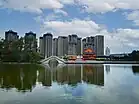 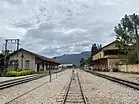 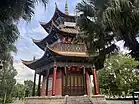 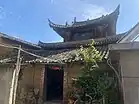 South Lake, Bisezhai Station Yingzhou Pavillion, Xin'ansuo Ancient Buildings | |
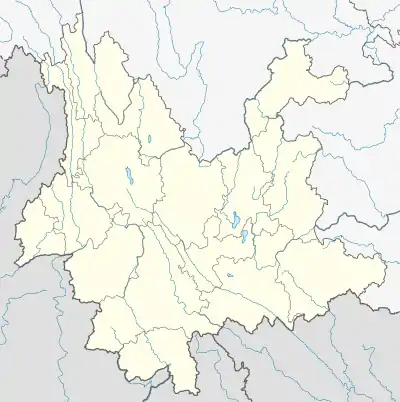 Mengzi Location in Yunnan  Mengzi Mengzi (China) | |
| Coordinates (Mengzi City government): 23°23′46″N 103°21′54″E | |
| Country | China |
| Province | Yunnan |
| Autonomous prefecture | Honghe |
| Municipal seat | Guanlan Subdistrict |
| Area | |
| • Total | 2,172 km2 (839 sq mi) |
| Elevation | 1,310 m (4,300 ft) |
| Population (2020 census)[1] | |
| • Total | 585,976 |
| • Density | 270/km2 (700/sq mi) |
| Time zone | UTC+8 (China Standard) |
| Postal code | 661100 |
| Area code | 0873 |
| Climate | Cwa |
| Website | www |
Name
Government
The municipal seat is in Guanlan Subdistrict.
Administrative divisions
At present, Mengzi City has 5 subdistricts, 4 towns, 2 townships and 2 ethnic townships.[8]
- 5 subdistricts
- Wenlan Subdistrict (文澜街道)
- Yuguopu Subdistrict (雨过铺街道)
- Guanlan Subdistrict (观澜街道)
- Wencui Subdistrict (文萃街道)
- Xin'ansuo Subdistrict (新安所街道)
- 4 towns
- Caoba (草坝镇)
- Zhicun (芷村镇)
- Mingjiu (鸣鹫镇)
- Lengquan (冷泉镇)
- 2 townships
- Shuitian Township (水田乡)
- Xibeilei Township (西北勒乡)
- 2 ethnic townships
- Qilu Bai and Miao Ethnic Township (期路白苗族乡)
- Laozhai Miao Ethnic Township (老寨苗族乡)
Geography and climate
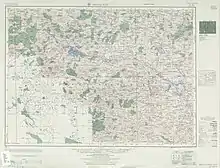
Located within 30 arc minutes south of the Tropic of Cancer, Mengzi, as with much of southern Yunnan, has a warm humid subtropical climate (Köppen Cwa), with muddled distinction between the seasons and daytime temperatures remaining warm year-round. Highs peak in May before the core of the rainy season and reach a minimum in December; however, the warmest and coolest months are June and December, respectively at 23.2 °C (73.8 °F) and 12.3 °C (54.1 °F); the annual mean is 18.65 °C (65.6 °F). June thru September accounts for over 60% of the annual rainfall of 857 mm (33.7 in) and during this time, some rainfall occurs on a majority of days, resulting in a marked reduction in sunshine. With monthly percent possible sunshine ranging from 34% in June and July to 64% in February, the city receives 2,161 hours of bright sunshine annually.
| Climate data for Mengzi (1991–2020 normals, extremes 1971–2000) | |||||||||||||
|---|---|---|---|---|---|---|---|---|---|---|---|---|---|
| Month | Jan | Feb | Mar | Apr | May | Jun | Jul | Aug | Sep | Oct | Nov | Dec | Year |
| Record high °C (°F) | 27.9 (82.2) |
30.7 (87.3) |
33.2 (91.8) |
35.9 (96.6) |
35.8 (96.4) |
34.5 (94.1) |
33.7 (92.7) |
32.4 (90.3) |
33.3 (91.9) |
30.4 (86.7) |
28.7 (83.7) |
27.0 (80.6) |
35.9 (96.6) |
| Average high °C (°F) | 18.8 (65.8) |
21.3 (70.3) |
25.1 (77.2) |
27.6 (81.7) |
28.4 (83.1) |
28.5 (83.3) |
27.8 (82.0) |
27.9 (82.2) |
27.0 (80.6) |
24.4 (75.9) |
22.0 (71.6) |
18.8 (65.8) |
24.8 (76.6) |
| Daily mean °C (°F) | 12.9 (55.2) |
15.1 (59.2) |
18.6 (65.5) |
21.4 (70.5) |
23.0 (73.4) |
23.8 (74.8) |
23.3 (73.9) |
22.9 (73.2) |
21.9 (71.4) |
19.5 (67.1) |
16.3 (61.3) |
13.1 (55.6) |
19.3 (66.8) |
| Average low °C (°F) | 8.8 (47.8) |
10.8 (51.4) |
14.1 (57.4) |
17.0 (62.6) |
19.2 (66.6) |
20.7 (69.3) |
20.4 (68.7) |
19.9 (67.8) |
18.6 (65.5) |
16.4 (61.5) |
12.5 (54.5) |
9.3 (48.7) |
15.6 (60.2) |
| Record low °C (°F) | −3.9 (25.0) |
1.0 (33.8) |
−1.8 (28.8) |
5.5 (41.9) |
9.9 (49.8) |
13.0 (55.4) |
13.5 (56.3) |
12.4 (54.3) |
8.6 (47.5) |
1.8 (35.2) |
−0.1 (31.8) |
−3.5 (25.7) |
−3.9 (25.0) |
| Average precipitation mm (inches) | 24.9 (0.98) |
15.6 (0.61) |
23.3 (0.92) |
50.2 (1.98) |
93.6 (3.69) |
110.5 (4.35) |
161.6 (6.36) |
141.5 (5.57) |
84.4 (3.32) |
56.5 (2.22) |
35.7 (1.41) |
19.1 (0.75) |
816.9 (32.16) |
| Average precipitation days (≥ 0.1 mm) | 5.0 | 4.4 | 5.7 | 8.9 | 12.8 | 15.5 | 19.6 | 19.0 | 13.3 | 9.3 | 5.3 | 3.8 | 122.6 |
| Average snowy days | 0.2 | 0 | 0 | 0 | 0 | 0 | 0 | 0 | 0 | 0 | 0 | 0 | 0.2 |
| Average relative humidity (%) | 70 | 64 | 60 | 61 | 65 | 72 | 76 | 77 | 74 | 74 | 72 | 72 | 70 |
| Mean monthly sunshine hours | 198.1 | 205.4 | 224.2 | 223.5 | 206.3 | 139.1 | 129.9 | 144.5 | 150.6 | 145.8 | 188.5 | 185.2 | 2,141.1 |
| Percent possible sunshine | 59 | 64 | 60 | 59 | 50 | 34 | 31 | 36 | 41 | 41 | 57 | 56 | 49 |
| Source 1: China Meteorological Administration[9][10] | |||||||||||||
| Source 2: Weather China[11] | |||||||||||||
Food
The Mengzi region is well known for a dish called guoqiao mixian ("Over the Bridge Rice Noodle"), made with long rice-flour noodles.
History
The history of Mengzi can be traced back to Western Han dynasty when Bengu County (贲古县) was founded (109 B.C.), which was currently the area of Xin'ansuo, Mengzi.
Not until in 1276 (Yuan dynasty), Mengzi county was formerly founded, which can be regarded as the prototype of the modern Mengzi City.
In the 19th century, Mengzi was a major trading center for commerce between the interior of Yunnan and the Northern area of Vietnam.
In 1886, a French convention chose Mengzi to be the center of trade in Yunnan province for importing and exporting goods via Tongking in Vietnam. Facilities for this opened two years later.
Communications were inconvenient: goods from Hanoi or Haiphong were shipped to Hekou on the Vietnamese border by junk, transferred by small craft to Manhao, and then taken 60 km (37 mi) by pack animal to Mengzi. Despite these difficulties, Mengzi was an important port of entry into both Yunnan and western Guizhou provinces, and in 1889 it was opened to foreign trade as a treaty port. Most of this foreign trade was in tin and opium. Its main exports were tin and opium, and the main imports were mostly textiles (primarily cotton) and tobacco.
As a trading center, the city gradually began to lose its importance beginning from the early 20th century. The importance of Mengzi was ended by the construction of the French railway from Haiphong to Kunming (the Yunnan provincial capital) in 1906–10. This railway bypassed Mengzi, but in 1915 a branch line was built via the town to the Gejiu tin mines. Apart from a brief respite during the early days of World War II, the town of Mengzi has, nevertheless, steadily declined in importance ever since.
Gejiu became a county in 1913, and a city in 1951. With the improvement of communications and transportation between cities of Gejiu and Kaiyuan and the other counties nearby, plus the development of trade between southwestern China and the countries of Southeast Asia, Mengzi's ties have increasingly strengthened with Gejiu and Kaiyuan. The whole area has become a border economic centre. In addition to tin, the county's natural resources include coal, manganese, lead, zinc, and antimony.
When Japanese troops drove Beijing and Tianjin university professors, students, and administrators out of those cities, and then later out of Changsha as well, the academics made their own long march to Yunnan Province. They first established themselves in Mengzi, but after a year or so moved on to the provincial capital, Kunming. This was Lianda, or the Southwest Associated Universities.
Recently, the prefectural government has moved from nearby Gejiu to Mengzi. New wealthy suburbs and large government offices have sprung up as a result, but much of the poverty remains, creating a large wealth gap within the city.
In 2012, 11-14 thousand year old early human bones from Maludong near Mengzi City (some of them already in museum collections) were reported. These are provisionally known as the Red Deer Cave people.[12]
Economy
Mengzi used to be an agricultural undeveleped county before it rebecame the prefectural capital city in 2003 and being upgraded to a city administratively in 2010.
Real estate industry is the backbone of city's industry. The local government has also been developing policies to promote the transformation of the city's industries in recent years and has achieved some success.[14]
Transport
Railway
- The narrow-gauge Kunming–Hai Phong railway, in the mountains east of the city (passenger service discontinued), and its branches
- Yuxi–Mengzi railway[15] (opened in 2013)
- Mengzi–Hekou railway (opened in December 2014); regular passenger service between Kunming and Hekou
- Mile–Mengzi high-speed railway (Honghe railway station)
Tram
Honghe tram runs from Mengzi North railway station to the city center.
Airport
Honghe Mengzi Airport in Mengzi is under construction.[16]
References
- "红河州第七次全国人口普查主要数据公报" (in Chinese). Government of Honghe Prefecture. 2021-06-04.
- Chisholm, Hugh, ed. (1911). . Encyclopædia Britannica. Vol. 18 (11th ed.). Cambridge University Press. p. 129.
- "红河州概况_红河网". www.hh.cn. Retrieved 2022-08-17.
- "蒙自市人民政府门户网站". www.mz.hh.gov.cn. Retrieved 2022-08-17.
- 云南蒙自县申报设市获得国家民政部批复—. Sina News. 13 October 2010. Retrieved 2011-03-22.
- "蒙自县-中国地名辞源-专业词典". www.zsbeike.com. Retrieved 2022-08-17.
- Little, Archibald John (2010), Little, Alicia (ed.), Across Yunnan: A Journey of Surprises, Cambridge University Press, ISBN 978-1108014090, originally published 1910. Pages 86 sq.
- "国家统计局" (in Chinese). National Bureau of Statistics of the People's Republic of China.
- 中国气象数据网 – WeatherBk Data (in Simplified Chinese). China Meteorological Administration. Retrieved 20 September 2023.
- 中国气象数据网 (in Simplified Chinese). China Meteorological Administration. Retrieved 20 September 2023.
- 蒙自 - 气象数据 -中国天气网 (in Chinese). Weather China. Retrieved 10 April 2023.
- "Human fossils hint at new species". BBC. Retrieved 2012-03-14.
- "我市与河口县、越南老街市举行党政领导视频会谈". The Official Website of People's Government of Mengzi City(蒙自市人民政府门户网). 2022-01-27. Retrieved 2022-12-24.
- "【红河这十年】蒙自:"农业大县"向"中心城市"的华丽蝶变_中国网". union.china.com.cn. Retrieved 2022-12-07.
- "CNC World - Major tunnel for asean railway". Archived from the original on 2012-02-29. Retrieved 2012-03-02.
- "红河蒙自机场开工建设". www.hh.gov.cn. Retrieved 2021-05-15.
